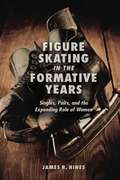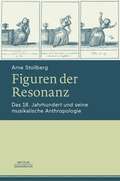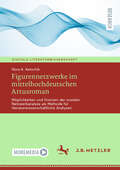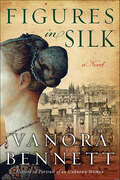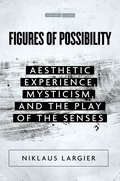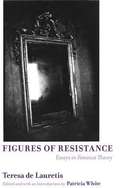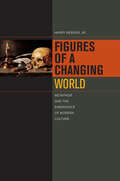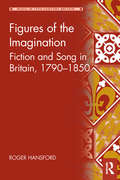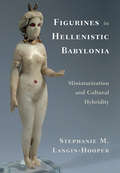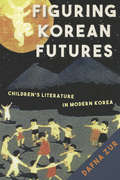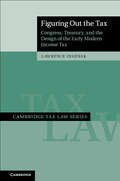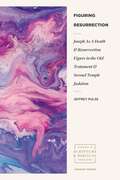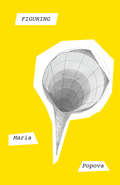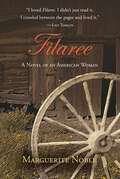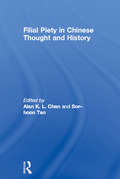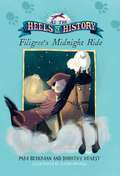- Table View
- List View
Figure Skating in the Formative Years: Singles, Pairs, and the Expanding Role of Women
by James R HinesOnce a winter pastime for socializing and courtship, skating evolved into the wildly popular competitive sport of figure skating, one of the few athletic arenas where female athletes hold a public profile--and earning power--equal to that of men. Renowned sports historian James R. Hines chronicles figure skating's rise from its earliest days through its head-turning debut at the 1908 Olympics and its breakthrough as entertainment in the 1930s. Hines credits figure skating's explosive expansion to an ever-increasing number of women who had become proficient skaters and wanted to compete, not just in singles but with partners as well. Matters reached a turning point when British skater Madge Syers entered the otherwise-male 1902 World Championship held in London and finished second. Called skating's first feminist, Syers led a wave of women who made significant contributions to figure skating and helped turn it into today's star-making showcase at every Winter Olympics. Packed with stories and hard-to-find details, Figure Skating in the Formative Years tells the early history of a sport loved and followed by fans around the world.
Figureheads of the Royal Navy
by David PulvertaftThe first figureheads that were carved to represent the names of British warships appeared during the reign of Henry VIII; the last ones were carved in the early years of the twentieth century. During the intervening three hundred and fifty years it is estimated that some 5000 ships of the Royal Navy carried a figurehead of some description. This book follows the development of these diverse carvings, examining how the figurehead carvers interpreted the names and the symbolism incorporated in their designs. Evidence is drawn from a wide range of sources: contemporary ship models, ship plans, designs submitted for approval of the Navy Board and, of course, from those figureheads that have survived.Lavishly illustrated with much previously unpublished material, the book explores the wide range of subjects that were represented on the bows of Their Majesties Ships and recounts many of the stories that were told about them.The narrative is complemented by a catalogue that provides a brief description of each surviving figurehead, each carvers design drawing with its source and reference number as well as those ship plans and contemporary models that show the figureheads detail. This combination makes the book useful to a wide range of historians, researchers and anyone with an interest in Britains maritime past.
Figuren der Resonanz: Das 18. Jahrhundert und seine musikalische Anthropologie
by Arne StollbergAb der Mitte des 17. Jahrhunderts vollzog sich in der Medizin ein Paradigmenwechsel von hoher ästhetischer Relevanz. Hatten die Nerven bis dahin als Transportkanäle für die „Lebensgeister“ gegolten, so trat nunmehr eine konkurrierende Theorie auf den Plan, nach der es sich um elastische Fasern handle, die in Analogie zur Saitenvibration, also über das Prinzip der Schwingung zu erklären seien. Der menschliche Leib avancierte buchstäblich zu einem Musikinstrument, das emotionale Erleben (nicht nur) von Musik zu einem Resonanzeffekt. Die Folgen dieser Sichtweise waren einschneidend: Das vorliegende Buch zeigt anhand zahlreicher Quellen aus den Bereichen Musik, Medizin, Literatur und Ästhetik, wie eine „musikalische Anthropologie“ entstand, die wiederum auf die Kompositionspraxis zurückwirkte, etwa bei Carl Philipp Emanuel Bach, Georg Anton Benda und Wolfgang Amadeus Mozart.
Figurennetzwerke im mittelhochdeutschen Artusroman: Möglichkeiten und Grenzen der sozialen Netzwerkanalyse als Methode für literaturwissenschaftliche Analysen (Digitale Literaturwissenschaft)
by Nora K. KetschikIn diesem Buch werden Figuren und Figurenkonstellationen in einem Korpus mittelhochdeutscher Artusromane mit computergestützten Methoden, insbesondere der Sozialen Netzwerkanalyse, untersucht. Die Analysen konzentrieren sich auf Hartmanns von Aue ‚Erec‘ und ‚Iwein‘ sowie auf Wolframs von Eschenbach ‚Parzival‘, und knüpfen an Fragestellungen zur Figurenkonzeption und Handlungsstruktur an. Die Arbeit verbindet digitale Prozesse der Datenerhebung und -auswertung mit literaturwissenschaftlichen Analysegegenständen und Fragestellungen. Dabei liegt ein besonderer Fokus auf der reflektierten Methodenentwicklung und der kritischen Evaluation der eingesetzten Verfahren.
Figures in Silk
by Vanora BennettJohn Lambert marries off his two beautiful daughters. The elder, Jane Shore, soon begins a notorious liaison with King Edward IV. The other sister, Isabel, is wed to the scion of a wealthy silk dynasty--and faces a monumental challenge when her husband is killed. Forced into apprenticeship to her mother-in-law, Alice Claver, Isabel learns to love the exotic fabrics from Italy, Persia, Spain, Tunisia, and beyond, discovering both loyal friends and dangerous enemies in this breathtaking new world.
Figures in Silk: A Novel
by Vanora Bennett“Bennett’s medieval England comes alive in ways a reader can immediately relate to, even while being transported away from the modern world.”—Christian Science MonitorThe story of two sisters caught up in the maelstrom of historic events, Figures in Silk by Vanora Bennett combines the fascinating art and history of silk making with political intrigue and a sweeping, unforgettable love story. A breathing immersion into a Tudor England torn asunder by the War of the Roses, Figures in Silk is historical fiction at its finest—a rare and welcome treat for readers captivated by the fiction of Tracy Chevalier, Sarah Dunant, Geraldine Brooks, Susan Vreeland, and the Boleyn novels of Phillipa Gregory.
Figures in a Western Landscape: Men and Women of the Northern Rockies
by Elizabeth Stevenson""Figures in a Western Landscape is an absolutely stunning book. A biographer's take on the story of the American West, it posits that the turns of history are based on people-major 'figures' who shape their time and place. In her sequence of biographical essays, Elizabeth Stevenson tells the story of the northern Rockies and, in particular, Montana, a state of mind even more than it is a state of the Union. As her readers have come to expect, she offers more than a mere recounting of events. Stevenson captures the humanity of her subjects."" -Charles Little, author of Louis Bromfield at Malabar and Greenways for AmericaThe northern Rocky Mountains and adjacent high plains were the last American West. Here was the final enactment of our national drama-the last explorations, the final battles of the Indian wars, the closing of the frontier. In Figures in a Western Landscape, award-winning biographer Elizabeth Stevenson humanizes the history of the region with a procession of individual lives moving across generations. Each of the sixteen men and women depicted left behind his or her own unique written record or oral history. The stories they have bequeathed are rich in revealing anecdote and colorful detail. Among them: Meriwether Lewis, America's ""most introspective explorer,"" John Kirk Townsend, known to the Chinooks as ""the bird chief,"" Pretty-Shield, wife of the Crow scout who warned Custer to turn back at Little Big Horn, James and Granville Stuart, early settlers lured by rumors of gold in the 1850s.In a concluding chapter, Stevenson draws on previously unpublished material to reveal new information about Martha Jane Cannary Burke, better known as Calamity Jane, the woman who could ride, shoot, and drive a mule team as well as any man (but who once failed to ""pass"" because she didn't cuss her mules like one). She lies buried in Deadwood, South Dakota, next to the man some said was her husband, Wild Bill Hickok.These and other men and women whose stories Stevenson
Figures of Memory: The Rhetoric of Displacement at the United States Holocaust Memorial Museum
by Michael Bernard-DonalsFigures of Memory examines how the United States Holocaust Memorial Museum (USHMM) in Washington, DC, uses its space and the design of its exhibits to "move" its visitors to memory. From the objects and their placement to the architectural design of the building and the floor plan, the USHMM was meant to teach visitors about the Holocaust. But what Michael Bernard-Donals found is that while they learn, and remember, the Holocaust, visitors also call to mind other, sometimes unrelated memories. Partly this is because memory itself works in multidirectional ways, but partly it's because of decisions made in the planning that led to the creation of the museum.Drawing on material from the USHMM's institutional archive, including meeting minutes, architectural renderings, visitor surveys, and comments left by visitors, Figures of Memory is both a theoretical exploration of memory—its relation to identity, space, and ethics—and a practical analysis of one of the most discussed memorials in the United States. The book also extends recent discussions of the rhetoric of memorial sites and museums by arguing that sites like the USHMM don't so much "make a case for" events through the act of memorialization, but actually displace memory, disturbing it—and the museum visitor—so much so that they call it into question. Memory, like rhetorical figures, moves, and the USHMM moves its visitors, figuratively and literally, both to and beyond the events the museum is meant to commemorate.
Figures of Possibility: Aesthetic Experience, Mysticism, and the Play of the Senses (Cultural Memory in the Present)
by Niklaus LargierFrom medieval contemplation to the early modern cosmopoetic imagination, to the invention of aesthetic experience, to nineteenth-century decadent literature, and to early-twentieth century essayistic forms of writing and film, Niklaus Largier shows that mystical practices have been reinvented across the centuries, generating a notion of possibility with unexpected critical potential. Arguing for a new understanding of mystical experience, Largier foregrounds the ways in which devotion builds on experimental practices of figuration in order to shape perception, emotions, and thoughts anew. Largier illuminates how devotional practices are invested in the creation of possibilities, and this investment has been a key element in a wide range of experimental engagements in literature and art from the seventeenth to the twentieth century, and most recently in forms of "new materialism." Read as a history of the senses and emotions, the book argues that mystical and devotional practices have long been invested in the modulating and reconfiguring of sensation, affects, and thoughts. Read as a book about practices of figuration, it questions ordinary protocols of interpretation in the humanities, and the priority given to a hermeneutic understanding of texts and cultural artifacts.
Figures of Resistance: Essays in Feminist Theory
by Patricia White Teresa De LauretisThe changing face of feminist discourse as reflected by the career of one of its preeminent scholars Figures of Resistance brings together the unpublished lectures and little-seen essays of internationally renowned theorist Teresa de Lauretis, spanning over twenty years of her finest work. Thirty years after the height of feminist theory, this collection invites us to reflect on the history of feminism and take a hard look at where it stands today. Selected essays include "Sexual Indifference and Lesbian Representation," "The Lure of the Mannish Lesbian," "Eccentric Subjects," "Habit Changes," "The Intractability of Desire," and the unpublished article "Figures of Resistance." An introduction from feminist film scholar Patricia White provides an overview of the development of de Lauretis's thought and of feminist theory over past decades.
Figures of Speech: First Amendment Heroes and Villains
by William TurnerRecounting controversial First Amendment cases from the Red Scare era to Citizens United, William Bennett Turner—a Berkeley law professor who has argued three cases before the Supreme Court—shows how we’ve arrived at our contemporary understanding of free speech. His strange cast of heroes and villains, some drawn from cases he has litigated, includes Communists, Jehovah’s Witnesses, Ku Klux Klansmen, the world’s leading pornographer, prison wardens, dogged reporters, federal judges, a computer whiz, and a countercultural comedian. This is a fascinating look at how the scope of our First Amendment freedoms has evolved and the colorful characters behind some of the most important legal decisions of modern times. “Turner tells fascinating stories of unlikely heroes and explains difficult legal issues clearly and concisely, educating and entertaining at the same time.”—Elizabeth Farnsworth, The PBS News Hour
Figures of Time: Affect and the Television of Preemption (Thought in the Act)
by Toni PapeMany contemporary television series from Modern Family to How to Get Away with Murder open an episode or season with a conflict and then go back in time to show how that conflict came to be. In Figures of Time Toni Pape examines these narratives, showing how these leaps in time create aesthetic experiences of time that attune their audiences to the political doctrine of preemption—a logic that justifies preemptive action to nullify a perceived future threat. Examining questions of temporality in Life on Mars, the political ramifications of living under the auspices of a catastrophic future in FlashForward, and how Damages disrupts the logic of preemption, Pape shows how television helps shift political culture away from a model of rational deliberation and representation toward a politics of preemption and conformity. Exposing the mechanisms through which television supports a fear-based politics, Pape contends, will allow for the rechanneling of television's affective force into building a more productive and positive politics.
Figures of a Changing World: Metaphor and the Emergence of Modern Culture
by Harry BergerFigures of a Changing World offers a dramatic new account of cultural change, an account based on the distinction between two familiar rhetorical figures, metonymy and metaphor. The book treats metonymy as the basic organizing trope of traditional culture and metaphor as the basic organizing trope of modern culture. On the one hand, metonymies present themselves as analogies that articulate or reaffirm preexisting states of affairs. They are guarantors of facticity, a term that can be translated or defined as fact-like-ness. On the other hand, metaphors challenge the similarity they claim to establish, in order to feature departures from preexisting states of affairs.On the basis of this distinction, the author argues that metaphor and metonymy can be used as instruments both for the large-scale interpretation of tensions in cultural change and for the micro-interpretation of tensions within particular texts. In addressing the functioning of the two terms, the author draws upon and critiques the work of Friedrich Nietzsche, Roman Jakobson, Christian Metz, Paul Ricoeur, Umberto Eco, Edmund Leach, and Paul de Man.
Figures of the Imagination: Fiction and Song in Britain, 1790–1850 (Music in Nineteenth-Century Britain)
by Roger HansfordThis new study of the intersection of romance novels with vocal music records a society on the cusp of modernisation, with a printing industry emerging to serve people’s growing appetites for entertainment amidst their changing views of religion and the occult. No mere diversion, fiction was integral to musical culture and together both art forms reveal key intellectual currents that circulated in the early nineteenth-century British home and were shared by many consumers. Roger Hansford explores relationships between music produced in the early 1800s for domestic consumption and the fictional genre of romance, offering a new view of romanticism in British print culture. He surveys romance novels by Ann Radcliffe, Matthew Lewis, Sir Walter Scott, James Hogg, Edward Bulwer and Charles Kingsley in the period 1790–1850, interrogating the ways that music served to create mood and atmosphere, enlivened social scenes and contributed to plot developments. He explores the connections between musical scenes in romance fiction and the domestic song literature, treating both types of source and their intersection as examples of material culture. Hansford’s intersectional reading revolves around a series of imaginative figures – including the minstrel, fairies, mermaids, ghosts, and witches, and Christians engaged both in virtue and vice – the identities of which remained consistent as influence passed between the art forms. While romance authors quoted song lyrics and included musical descriptions and characters, their novels recorded and modelled the performance of songs by the middle and upper classes, influencing the work of composers and the actions of performers who read romance fiction.
Figurierte Zahlen: Veranschaulichung als heuristische Strategie
by Jochen ZiegenbalgDieses Buch behandelt die Visualisierung als Methode des mathematischen Problemlösens, Begründens und Beweisens: Konkrete Beispiele zur Veranschaulichung durch mathematische Figuren und Bilder bieten einen faszinierenden Einblick in das Argumentieren anhand strukturierter und strukturierender Figuren zur Betrachtung von Zahlen und Zahlenfolgen. Die historischen Wurzeln dieses mathematischen Handwerkszeugs werden dabei so weit wie möglich einbezogen. Die Beispiele sind in der Regel konstruktiver Natur; gelegentlich wird, wo angebracht, die algorithmische Erschließung durch Hinweise auf die Programmierung mit Hilfe von Computeralgebra Systemen ergänzt. Das Buch richtet sich an Studierende und Lehrende an Schulen und Hochschulen, sowie an alle an der Elementarmathematik interessierten Nichtspezialisten, die das mathematische Arbeiten einmal außerhalb der von den Bildungsinstitutionen vorgezeichneten Pfade kennenlernen wollen. Es liefert insbesondere Lehrkräften und Lehramtsstudierenden wertvolle Anregungen, etwa zur Förderung mathematisch interessierter Schülerinnen und Schüler. In der 2. Auflage ist mit den mathematisch fundamentalen und historisch bedeutsamen Themen Wechselwegnahme, Teilbarkeit, Euklidischer Algorithmus, Inkommensurabilität und Kettenbrüche ein neues, für Visualisierungen gut geeignetes Kapitel hinzugekommen. Bereits bestehende Kapitel wurde durch Abschnitte über Trapezzahlen, ungerade Quadratzahlen und zentrierte Polygonalzahlen ergänzt.
Figurines in Hellenistic Babylonia: Miniaturization and Cultural Hybridity
by Stephanie M. Langin-HooperIn this volume, Stephanie M. Langin-Hooper investigates the impact of Greek art on the miniature figure sculptures produced in Babylonia after the conquests of Alexander the Great. Figurines in Hellenistic Babylonia were used as agents of social change, by visually expressing and negotiating cultural differences. The scaled-down quality of figurines encouraged both visual and tactile engagement, enabling them to effectively work as non-threatening instruments of cultural blending. Reconstructing the embodied experience of miniaturization in detailed case studies, Langin-Hooper illuminates the dynamic process of combining Greek and Babylonian sculpture forms, social customs, and viewing habits into new, hybrid works of art. Her innovative focus on figurines as instruments of both personal encounter and global cultural shifts has important implications for the study of tiny objects in art history, anthropology, classics, and other disciplines.
Figuring Korean Futures: Children’s Literature in Modern Korea
by Dafna ZurThis book is the story of the emergence and development of writing for children in modern Korea. Starting in the 1920s, a narrator-adult voice began to speak directly to a child-reader. This child audience was perceived as unique because of a new concept: the child-heart, the perception that the child's body and mind were transparent and knowable, and that they rested on the threshold of culture. This privileged location enabled writers and illustrators, educators and psychologists, intellectual elite and laypersons to envision the child as a powerful antidote to the present and as an uplifting metaphor of colonial Korea's future. Reading children's periodicals against the political, educational, and psychological discourses of their time, Dafna Zur argues that the figure of the child was particularly favorable to the project of modernity and nation-building, as well as to the colonial and postcolonial projects of socialization and nationalization. She demonstrates the ways in which Korean children's literature builds on a trajectory that begins with the child as an organic part of nature, and ends, in the post-colonial era, with the child as the primary agent of control of nature. Figuring Korean Futures reveals the complex ways in which the figure of the child became a driving force of nostalgia that stood in for future aspirations for the individual, family, class, and nation.
Figuring Out the Past: The 3,495 Vital Statistics that Explain World History
by Peter Turchin Daniel HoyerWhat was history's biggest empire? Or the tallest building of the ancient world? What was the plumbing like in medieval Byzantium? The average wage in the Mughal Empire? Where did scientific writing first emerge? What was the bloodiest ever ritual human sacrifice?We are used to thinking about history in terms of stories. Yet we understand our own world through data: cast arrays of statistics that reveal the workings of our societies. In Figuring Out the Past, radical historians Peter Turchin and Dan Hoyer dive into the numbers that reveal the true shape of the past, drawing on their own Seshat project, a staggeringly ambitious attempt to log every data point that can be gathered for every society that has ever existed. This book does more than tell the story of humanity: it shows you the big picture, by the numbers.
Figuring Out the Tax Congress: Treasury, and the Design of the Early Modern Income Tax (Cambridge Tax Law Series)
by Lawrence ZelenakFiguring Out the Tax recounts the forgotten early development of the federal income tax in the US, resulting from the interplay between Congress and the Treasury Department in the decades following the enactment of the tax in 1913. It covers a wide range of topics including the income tax treatments of marriage, capital losses, charitable contributions and homeownership, as well as the rise, demise and resurrection of income tax withholding. Lawrence Zelenak deftly illustrates how the income tax achieved its current form through a range of stories which are new to tax history scholarship and involve some remarkable personalities and surprising plot twists. Although of particular interest to tax academics and professionals, this book will also serve as a useful introduction to the development of income tax for undergraduate students and law students. Recounts important developments in the early history of the income tax utilising new material which is not covered in existing tax history scholarship. Adopts a chronological narrative approach, making for an entertaining read. Does not assume any particular background in income tax law and will be accessible to a general readership with an interest in income tax.
Figuring Resurrection: Joseph as a Death and Resurrection Figure in the Old Testament and Second Temple Judaism (Studies in Scripture and Biblical Theology)
by Jeffrey PulseThe death and resurrection of Joseph Towards the end of Genesis, the narrative slows down to tell the story of Joseph. There is no dispute that Joseph's story is unique, but why does it deserve such focused attention? And how does this story relate to the rest of Genesis? In Figuring Resurrection, Jeffrey Pulse presents the view that Joseph is a death-and-resurrection- figure. A close literary reading of Genesis 37–50 reveals that Joseph's story is one of rejection and restoration, descent and ascent, condemnation and exaltation, exile and return, death and resurrection. Far from a lengthy diversion, Joseph's story of "death and resurrection" plays an important role in the theology of Genesis and later Second Temple Jewish literature. Figuring Resurrection has implications for our understanding of Joseph's narrative, the book of Genesis, Hebrew thinking on the afterlife, and typology.
Figuring: Fortune Favours The Fast
by Maria PopovaFiguring explores the complexities of love and the human search for truth and meaning through the interconnected lives of several historical figures across four centuries—beginning with the astronomer Johannes Kepler, who discovered the laws of planetary motion, and ending with the marine biologist and author Rachel Carson, who catalyzed the environmental movement. <P><P>Stretching between these figures is a cast of artists, writers, and scientists—mostly women, mostly queer—whose public contribution have risen out of their unclassifiable and often heartbreaking private relationships to change the way we understand, experience, and appreciate the universe. Among them are the astronomer Maria Mitchell, who paved the way for women in science; the sculptor Harriet Hosmer, who did the same in art; the journalist and literary critic Margaret Fuller, who sparked the feminist movement; and the poet Emily Dickinson. <P><P>Emanating from these lives are larger questions about the measure of a good life and what it means to leave a lasting mark of betterment on an imperfect world: Are achievement and acclaim enough for happiness? Is genius? Is love? <P><P>Weaving through the narrative is a set of peripheral figures—Ralph Waldo Emerson, Charles Darwin, Elizabeth Barrett Browning, Herman Melville, Frederick Douglass, Nathaniel Hawthorne, and Walt Whitman—and a tapestry of themes spanning music, feminism, the history of science, the rise and decline of religion, and how the intersection of astronomy, poetry, and Transcendentalist philosophy fomented the environmental movement. <P><b>A New York Times Bestseller</b>
Fiji My Island Home: Country village life including Sugar Cane Farmers - Fiji
by Dr Kamlesh SharmaFiji: my island home provides an extraordinary insight in the daily livelihood of the poor sugar cane farmers in Fiji. The book discloses the struggles, survival and contributions to the local economy by farmers who toil on small pieces of land ranging in sizes of three to five acres each. These are leased from the Indigenous owners for a fixed term with no provision for further extension. The public bus services in Fiji are vividly narrated to capture the true essence of the word 'Fiji Time'. The book tries to build bridges of remembrance, understanding and reconciliation amongst Fijians of diverse cultural backgrounds. Finally, the book very clearly articulates and communicates the message that no matter where a Fijian is located in the world, one can never part from the fond memories of the island home!
Filaree: A Novel of an American Woman
by Marguerite NobleThis moving novel of pioneer life in Arizona has become a classic. Based on the life of the author's mother, it overturns every stereotype of western womanhood. Comes closer to the truth and the validity of the so-called winning of the West than anything I have ever read. It is terrifying, heartbreaking and remarkable. . . . Filaree is also one of the most magnificent portraits of a woman that exists in our literature.--Howard Fast I loved Filaree, I didn't just read it, I crawled between the pages and lived it.--Lily TomlinAn extraordinary performance. . . . a powerful antidote to the romantic illusions some people have about ranch people and life on the range. . . . As a writer, Mrs. Noble makes no compromises. She tells her story in plain country American dialect, offers no exaggerated sex or violence, no vulgar talk. She is a realist in the best sense, a breath of fresh air in these free-wheeling times.--C. L. Sonnichsen
Filial Piety in Chinese Thought and History
by Sor-Hoon Tan Alan ChanThe phenomenon of filial piety is fundamental to our understanding of Chinese culture, and this excellent collection of essays explores its role in various areas of life throughout history. Often regarded as the key to preserving Chinese tradition and identity, its potentially vast impact on government and the development of Chinese culture makes it extremely relevant, and although invariably virtuous in its promotion of social cohesion, its ideas are often controversial. A broad range of topics are discussed chronologically including Confucianism, Buddhism and Daoism, making it essential reading for those studying Chinese culture, religion and philosophy. This is a multi-disciplinary survey that combines historical studies with philosophical analysis from an international team of respected contributors.
Filigree's Midnight Ride (At the Heels of History)
by Dorothy Hearst Pam BerkmanJoin Filigree, a five-pound Pomeranian, as he stows away on Paul Revere’s midnight ride in this first book of the At the Heels of History series, inspired by important events and told through the eyes, ears, and noses of dogs.Filigree may be a small puff of a Pomeranian but he has a big, brave heart. As the Revere family dog, he’s ready to do his part to help the American colonists stand up to the British soldiers. But the other dogs, like Jove, Sam Adams’s Newfoundland, and even the Revere cat, Anvil, think Filigree is a joke. The Reveres’ daughter Frances is the only one who believes in him. When Frances’s father, Paul Revere, leaves home on a secret mission, Filigree and Frances know they have to help, no matter how dangerous it might be. Will a pint-sized pup just be in the way, or can Filigree prove that even a very small dog can fight for freedom?
